Blog & Latest Updates
Fly Fishing Articles
Insects by Common Name


Mayfly Species Hexagenia limbata (Hex)
Taxonomic Navigation -?-
Kingdom
Animalia (Animals)
» Phylum
Arthropoda (Arthropods)
» Class
Insecta (Insects)
» Order
Ephemeroptera (Mayflies)
» Family
Ephemeridae (Hexes and Big Drakes)
» Genus
Hexagenia
» Species limbata (Hex)
Common Names
This Midwestern legend plays out every year on calm, dark, humid nights in early July. Anglers who only fly fish once a year drive hundreds of miles to play their part in the drama, while the mayflies themselves make the television news by showing up on doppler radar or calling snowplows out of dormancy to remove layers of Hexagenia (or "Hex") duns from the bridges. In the cold trout rivers of Wisconsin and Michigan, huge nocturnal brown trout whose usual menu consists of smaller brown trout become, for a week or so, prime dry fly quarry.
According to the literature, these are the second largest mayflies in the United States, behind the related Litobrancha recurvata flies. However, there are credible reports of limbata exceeding 40mm in some locales that challenge this assumption.
Where & When
Regions: East, Midwest
Time Of Year (?): June through September, but the legendary hatches are in late June and early July.
Preferred Waters: Slow stretches of rivers and silty flats on lake bottoms
This species is transcontinental in distribution whose only limiting factor is proper habitat. It probably occurs in every state but Alaska, Arizona, and New Mexico. It can reach incredible densities in parts of Texas and Louisiana, but these waters are too warm for trout. It is in California and Oregon where limbata's most prolific western hatches in trout water occur. These dramatic hatches have become legendary over the last thirty years and the month long period starting sometime in early June is important to a host of anglers. They can also provide angling opportunities in other western states as well.Time Of Year (?): June through September, but the legendary hatches are in late June and early July.
Preferred Waters: Slow stretches of rivers and silty flats on lake bottoms
Though it is receiving growing notoriety in the West for providing excellent angling opportunities, Hexagenia Limbata won its first fame on the trout streams of Michigan and Wisconsin. It's found in rivers of all sizes and temperatures, including the mighty Mississippi whose vast mud flats put this hatch--literally--on the radar. Stillwaters from tiny spring ponds to Lake Erie can also have good hatches.
The Hex hatch begins in early June in the Driftless Area of Wisconsin and other southerly trout waters. It moves to the northern part of the Upper Midwest through the next several weeks, peaking in the last half of June and first half of July in most of the famous rivers. It lingers into August in the coldest headwaters of this region, as well as in the Northeast, where it is more restricted to stillwaters.
Because of the strict substrate requirements of Hexagenia nymphs, most rivers (even in the heart of their range) do not support good populations. Others have only a few places, a pool here and a run there, with good Hex activity. Nations guard their military secrets less closely than Hex fishermen guard these precious locations. If you wish to look for this hatch away from well-known Hex rivers, you cannot just pick from the map at random. Instead, check with fly shops and follow every whispered rumor. No other hatch creates so much mania on so little water.
Hatching Behavior
Time Of Day (?): Usually dusk, sometimes late at night, midday once in a great while.
Habitat: Near the silt bed habitat of the nymphs
The Hex emergence begins at twilight and is most intense then, but it often continues to provide fishable action for hours, even past midnight. Wisconsin guide and writer Brad Bohen observes that the Hex hatch commences within a few minutes of the nightly start of the whippoorwills. Habitat: Near the silt bed habitat of the nymphs
There is disagreement between authors about the manner of emergence. Some say these mayflies take a long time to struggle free from their shucks (
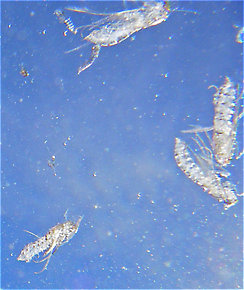
Here's an underwater view of the pupal shucks of several already-emerged Brachycentrus numerosus caddisflies.
Although the dialy timing of this hatch is predictable, the days when it will occur are not. One night may be so intense the fish can't find your fly among the naturals, and the next night can seem identical but be completely devoid of flies. Hot, humid nights are best, especially when it's very dark. There are old-timers who can feel it in the air when it is coming, but nobody has figured out how to put this sixth sense to words. Ernest Schwiebert described one such fellow in Matching the Hatch:
"According to one local angler I met on the Baldwin, the best nights are "dark as the inside o' yer hat; sorta warm an' muggy." He had three browns over seventeen inches."
Sometimes on cloudy days these duns emerge in the afternoon and the fishing can be incredible. Everybody envies the lucky angler who stumbles onto the rare "Daytime Hex Hatch."
In the West, muggy conditions rarely if ever occur, but wind is common. This affects the fishing approach somewhat. Anglers pray for a soft overcast day that usually brings them on early if it isn't too cold. Nymphs are very effective to fish pre-hatch, especially in still waters. On windy, inclement days, it may be the only way to stir up any action. During normal high pressure conditions the hatching and angling approach are as described above for the Midwest once the hatch commences at last light.
Spinner Behavior
Time Of Day: Shortly after dark.
Habitat: Near where the duns emerged
Hexagenia limbata spinner falls are even more impressive than the emergence. They return to the river from 1 to 3 days after emerging as duns. They fly at an altitude from five feet up to treetop level for a while before mating and falling spent (Spent: The wing position of many aquatic insects when they fall on the water after mating. The wings of both sides lay flat on the water. The word may be used to describe insects with their wings in that position, as well as the position itself.). Sometimes this flight leads them steadily upstream for miles, but other times the whole swarm flies up and down along 100 feet of river over and over again. When the time comes to lay their eggs, the females sometimes drop them from the air, but more frequently they land on the water.Habitat: Near where the duns emerged
The large spinners are buoyant and float on the surface for a long time. This can provide good Hex fishing in water far downstream from the original habitat of the nymphs. I once caught two browns, 21 and 24 inches, during a rise to Hex spinners that littered the water from some unseen swarm upstream. There was not a single fly in the air.
Nymph Biology
Current Speed: Slow streams or stillwater.
Substrate: Silt beds of just the right consistency, soft enough to easily burrow into but strong enough that they don't collapse
Environmental Tolerance: They survive in warm water but thrive in cold. They are very durable once they've grown large.
Hexagenia nymphs dig U-shaped burrows in the silt to a depth of less than six inches. They must do this in parts of the river where the silt is soft enough to burrow into but rigid enough that the burrows don't collapse; this is the same muck that is easy to sink into but tugs like a living beast when you try to pull free. You fear to wade through this mire in the dark, but the largest trout of the year beckon and fear is not so strong.Substrate: Silt beds of just the right consistency, soft enough to easily burrow into but strong enough that they don't collapse
Environmental Tolerance: They survive in warm water but thrive in cold. They are very durable once they've grown large.
Where the right marl (Marl: Loose sand, silt, or clay containing a high concentration of calcium carbonate.) is found, it can support up to 500 nymphs per square foot. The nocturnal nymphs only come out of their burrows to molt, which they do over 30 times in the 2-3 years they take to mature. (By some reports, they also leave their burrows to feed.) Because there are so many nymphs, their sporadic appearances add up to a great year-round food source for the trout where they are most abundant. Caucci and Nastasi do the math in Hatches II and conclude that a trout may see up to 2,000 Hexagenia limbata nymphs per day during non-hatch periods in prime habitat. The real encounter rate is probably much lower, but anything in that ballpark is a major food source. The nymphs are confirmed as a year-round trout food by stomach samples gathered by both the Leonards and Swisher and Richards.
Fred Arbona writes in Mayflies, the Angler, and the Trout that fishing a nymph deep and lifting it up toward the surface occasionally is the most effective way to fish this hatch. The method may work well, but most anglers do not wish to squander the best dry fly opportunity of the year by tossing nymphs into the darkness!
Hexagenia limbata Fly Fishing Tips
In reality, there are times when Hexagenia limbata poses selectivity challenges to rival any other insect in the country. This is especially true in its final weeks, when the trout are conditioned to expect a full meal and they take their sweet time getting it. Some fish fill up on nymphs and do not rise at all. Others pose classic selectivity problems: they want only dead-drifting (Dead-drift: The manner in which a fly drifts on the water when not moving by itself or by the influence of a line. Trout often prefer dead-drifting prey and imitating the dead-drift in tricky currents is a major challenge of fly fishing.) or fluttering duns, only half-spent (Spent: The wing position of many aquatic insects when they fall on the water after mating. The wings of both sides lay flat on the water. The word may be used to describe insects with their wings in that position, as well as the position itself.) or spent (Spent: The wing position of many aquatic insects when they fall on the water after mating. The wings of both sides lay flat on the water. The word may be used to describe insects with their wings in that position, as well as the position itself.) spinners, only males or only females (which are larger). Such large mayflies are easy for trout to scrutinize even in the dark, and sloppy imitations are often ignored.
Because much of this action takes place in pitch darkness, there is a whole new set of challenges to be met and skills to be learned. Ernest Schwiebert describes the subtle touch:
"Night fishing can get into your blood, and your senses become amazingly attuned to it. You will find yourself casting accurately to rises you only hear. The slightest disturbance near your fly puts the reflex on edge; you must strike at these rises, for it is easy to assume your fly to be elsewhere and never strike at a good fish."
Carl Richards offers another good tip in a short essay in Mayflies: An Angler's Study of Trout Water Ephemeroptera :
The trick for night fishing the Hex hatch is to get as close as possible. Experienced anglers know the water, wade into position, and cast a very short line. They fish strictly to sound and strike on the splash.
I'm not sure how anyone fishes "strictly to sound." My ears cannot sense distance and direction that well. But I have learned to keep my eyes alert for the faintest hint of the glint of a ripple in the surface that may signify a rise.
Some of the best Hex anglers learn where the biggest trout live and stake out their positions before dusk. They wait like patient hunters, rather than fishermen, for their trophy to rise. They know its schedule. They study its feeding rhythm. They match their wits against its instincts night after night until they hook it, and then the game is won whether they bring their quarry to hand or not.
Pictures of 28 Mayfly Specimens in the Species Hexagenia limbata:
Male Hexagenia limbata (Hex) Mayfly Spinner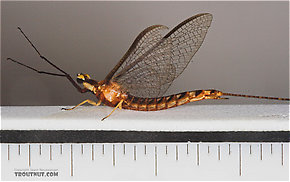 View 13 Pictures
View 13 Pictures
 View 13 Pictures
View 13 PicturesCollected June 26, 2005 from Atkins Lake in Wisconsin
Added to Troutnut.com by Troutnut on May 26, 2006
Added to Troutnut.com by Troutnut on May 26, 2006
Hexagenia limbata (Hex) Mayfly Nymph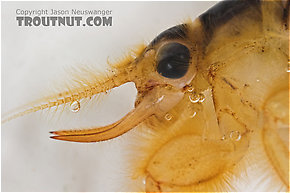 View 9 Pictures
View 9 Pictures
 View 9 Pictures
View 9 PicturesCollected June 8, 2005 from the Namekagon River in Wisconsin
Added to Troutnut.com by Troutnut on May 26, 2006
Added to Troutnut.com by Troutnut on May 26, 2006
Female Hexagenia limbata (Hex) Mayfly Spinner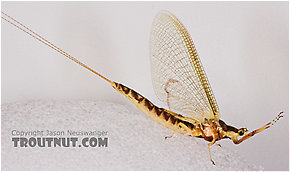 View 8 Pictures
View 8 Pictures
 View 8 Pictures
View 8 PicturesCollected June 28, 2005 from the White River in Wisconsin
Added to Troutnut.com by Troutnut on May 26, 2006
Added to Troutnut.com by Troutnut on May 26, 2006
1 Underwater Picture of Hexagenia limbata Mayflies:
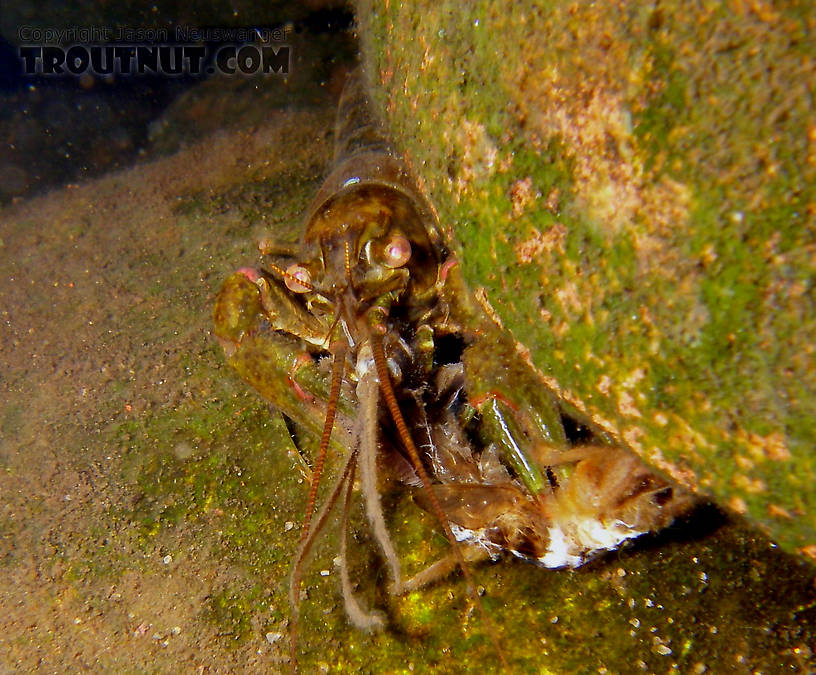
A crayfish chews on a Hexagenia limbata nymph shortly after a small Hex emergence. I didn't catch any fish, but playing around with my flashlight and camera in the rocks proved productive.
In this picture: Arthropod Order Decapoda (Crayfish) and Mayfly Species Hexagenia limbata (Hex).
In this picture: Arthropod Order Decapoda (Crayfish) and Mayfly Species Hexagenia limbata (Hex).
StateWisconsin
LocationNamekagon River
Date TakenJun 14, 2006
Date AddedJun 30, 2006
AuthorTroutnut
CameraPENTAX Optio WPi
Blizzard-like Hex Hatch
Starring: Mayfly Species Hexagenia limbata
LocationNamekagon River
Date ShotJun 18, 2005
Date AddedMar 31, 2006
AuthorTroutnut
CameraOlympus C740UZ
Another Hexagenia
Starring: Hexagenia limbata Mayfly Nymph
Hexagenia
Starring: Hexagenia limbata Mayfly Nymph
This is one of the earliest videos I made, and I was experimenting with a tank and background that didn't work very well.
Recent Discussions of Hexagenia limbata
Hex hatch water temperature range? 4 Replies »
Hi,
New to the site - love it. I was wondering if there was a suggested range of water temperature at which the Hex likes to hatch.
Thanks
Matt
ReplyWhat is the big DEAL about the HEX? 21 Replies »New to the site - love it. I was wondering if there was a suggested range of water temperature at which the Hex likes to hatch.
Thanks
Matt
fishing in the dark.......
stepping in holes?
I hate the dark........
I don't need the hex........
Len
ReplyMayfly larvae -wigglers preservation as bait 20 Replies »stepping in holes?
I hate the dark........
I don't need the hex........
Len
Posted by Teacherprea on Jun 2, 2007
Last reply on Apr 29, 2014 by TNEAL
I am a fly fisherman but not a "purist". A friend of mine has a place on the UP of Michigan. He just called me and said a guy told him there is a way to preserve "wigglers." They use them alot up north, those that are not fly fishermen or ladies. They are fishing perch, bluegill and crappie. He heard there is a way to "blanch" them.Drop them in hot water for a few minutes and they turn rubbery. They then will keep indefinitely. Has anyone heard of this? If so, how close to correct is the procedure I mentioned??
Thanks for anyone's help.
ReplyHex nymph behavior 9 Replies »Thanks for anyone's help.
I have read in many places that the Hex nymph is a mud dweller. What does this mean? Does this mean they immediately change from egg to nymph and then burrow into the mud until emergence or do they simply burrow in the mud to find food and spend some time in the open water between meals? I have heard comments from fisherman that indicate they know the hatch has been happening when they see small holes in the muddy banks of the river. This is abit confusing to me. Could someone please clarify.
ReplyHex is next!Posted by AftonAngler on Jun 10, 2006
Well the Hex is right on the cusp of happening...
I have heard rumors of some being spotted on the Nam...about right. I usually set me clock by the Solstice but this season is about ten days to two weeks ahead.
I expect them to show on the Brule anytime too. The next warming trend should usher in some of the big fellows and that will mean no sleep for a couple of weeks for this cat.
I need to sit down and get to tying. I had great success last year with a very 'soft' spinner pattern I dubbed Baby Doll Hex. It was floppy by hex spinner standards and best the pants off the stiff Lucca style patterns that look good int he fly bin but are not for me on the end of my leader when the rubber hits the road!
I also need to reread Galloup's "Cripples and Spinners" - a wealth of info on this aspect of the sport. Great for inspiring tying ideas...
Anyone confirm the reports?
ReplyI have heard rumors of some being spotted on the Nam...about right. I usually set me clock by the Solstice but this season is about ten days to two weeks ahead.
I expect them to show on the Brule anytime too. The next warming trend should usher in some of the big fellows and that will mean no sleep for a couple of weeks for this cat.
I need to sit down and get to tying. I had great success last year with a very 'soft' spinner pattern I dubbed Baby Doll Hex. It was floppy by hex spinner standards and best the pants off the stiff Lucca style patterns that look good int he fly bin but are not for me on the end of my leader when the rubber hits the road!
I also need to reread Galloup's "Cripples and Spinners" - a wealth of info on this aspect of the sport. Great for inspiring tying ideas...
Anyone confirm the reports?
Your Thoughts On Hexagenia limbata:
Top 10 Fly Hatches
Top Gift Shop Designs
Eat mayflies.
Top Insect Specimens
Miscellaneous Sites
Troutnut.com is copyright © 2004-2024 Jason
Neuswanger (email Jason). See my FAQ for information about use of my images.
 privacy policy
privacy policy

The Namekagon is not known as a Hex hatch river, for good reason: the hatch is extremely rare and localized, and there are often few if any trout where the Hexes are. During this trip I caught nothing and heard no risers, but it was still a memorable night out in the middle of nowhere.